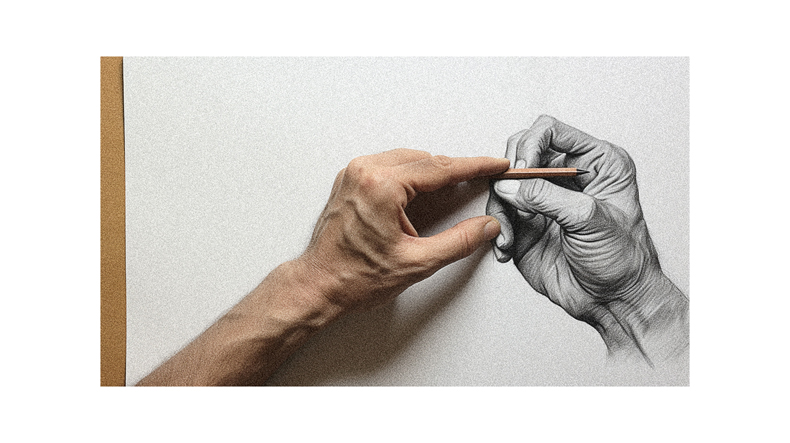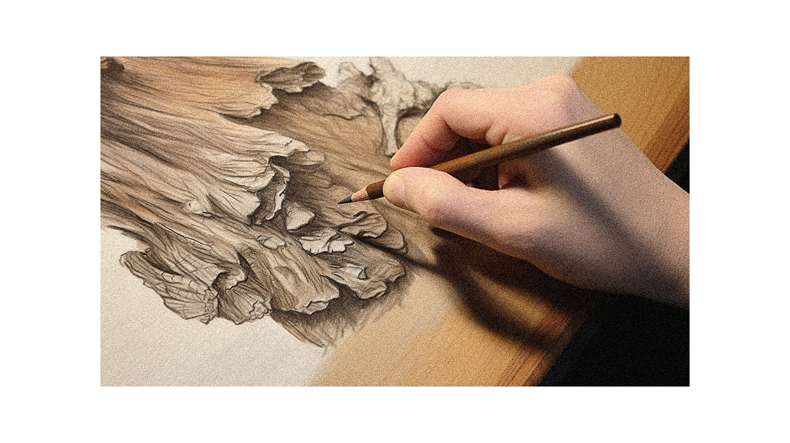You’ve always dreamed of sketching, but it seems daunting, right? Fear not! ‘Sketching Fundamentals for Beginners’ is for you. No experience? No problem. Here, you’ll master shape, measurement, light, and space. Grab your pencil, shake off doubts, and start your artistic journey.
Through patience and practice, you’ll see the world as an artist does – beautiful and rewarding. It’s time to explore your artistic vision. Let’s draw!
Basic Sketching Techniques

Understanding basic sketching techniques is vital in enhancing your creativity and artistic expression. You must grasp the concepts of shapes, light, space, and measurement. These are the building blocks of any sketch.
Don’t shy away from exploring subjects in depth, with a focus on composition and mark-making. This exploration allows you to view the world through an artist’s lens, deepening your understanding and sharpening your skills.
Understanding Line and Shape

How accurately can you depict a shape using just simple lines? You’d be surprised! It’s all about understanding lines and their relationship to the shapes they form. When you’re sketching, don’t focus on the object. Instead, simplify it into basic shapes and lines. See a cat? That’s a series of ovals and triangles. A house? Just squares and rectangles.
Practice this skill by sketching everyday objects and breaking them down into simple shapes. Remember, you’re not aiming for a masterpiece. You’re training your eye to see shapes in the world around you.
Exploring Value and Shading

Interestingly, you’re now delving into the realm of value and shading, which can dramatically enhance the depth and realism of your sketches. It’s all about understanding light and how it interacts with different objects.
Start by identifying your subject’s light, mid, and dark tones. This skill is crucial because your drawings can appear flat and lifeless without it.
Next, you’ll want to practice shading. This involves using a range of tones to create a sense of volume and depth. Remember, it’s okay to make mistakes. That’s how you learn.
Lastly, don’t forget to apply your knowledge of value and shading to different textures and materials. This will add another layer of complexity and realism to your sketches. Keep practicing. You’re getting better with every stroke.
Perspective Drawing Essentials

You’re about to dive into the essentials of perspective drawing, a fundamental skill key to creating realistic sketches. It’s all about creating a three-dimensional illusion on a flat surface. Your first step is understanding the horizon line and vanishing points.
Remember, the one-point perspective uses one vanishing point, the two-point perspective uses two, and so on. Next, you’ll learn to draw objects in perspective. They’ll seem to shrink as they move away from you, mimicking how we see the world. It’ll take practice, but soon you’ll start to see improvement.
And don’t forget mistakes are part of the learning process. So, grab your sketchbook, let’s get drawing. Perspective is about to become your new best friend in your artistic journey.
Capturing Proportions and Proportional Relationships

In mastering sketching, you’re capturing shapes and tackling the challenge of capturing proportions and proportional relationships, a key component in creating realistic and balanced drawings. You’re learning to see the size, distance, and angle relationships between objects. This isn’t always easy, as your brain often wants to take shortcuts, but with practice, you’ll improve.
Start by studying your subject closely. Make sure to take note of the size of each part about the others, not just in isolation. When you’re drawing, checking and rechecking these relationships is helpful.
You could use a pencil or your thumb to measure. Remember, it’s not a race. You’re developing a vital skill, and accuracy matters more than speed. With patience, you’ll soon see your sketches improve.
Adding Depth and Dimension to Your Sketches

When you add depth and dimension to your sketches, you enhance your art’s visual appeal and demonstrate your understanding of perspective and space.
It’s not as daunting as it sounds. Start by understanding that every object occupies space with a specific mass or volume. You’re not just drawing lines on a flat surface but creating a three-dimensional representation.
Master the use of lines, angles, and shading. They’re your best friends in sketching. Lines create boundaries, angles give direction, and shading adds volume. Don’t worry about getting it right the first time. It’s a process. Practice using these elements until they become second nature. Remember, the goal isn’t perfection; it’s progress. You’ll find your sketches gaining depth and dimension with patience and perseverance. And that’s when the magic happens.
Exploring Different Drawing Materials

There’s a whole world of drawing materials, but let’s focus on the top five you should consider exploring first. Start with graphite pencils. They’re versatile and great for sketching.
Next, try charcoal. It’s perfect for expressive, dramatic work. Third, colored pencils offer a range of hues for your drawings.
Fourth, consider using ink. It creates bold, distinct lines that can’t be erased, which boosts your confidence in mark-making. Lastly, explore pastels; they allow you to blend colors smoothly.
Remember, it’s not about mastering all materials but finding the ones that complement your style. Experiment, have fun, and discover the medium that speaks to your artistic voice.
Creating Texture and Detail in Your Sketches

While you’re adding depth and realism to your sketches, it’s essential to create texture and detail carefully, as this can significantly enhance the overall visual impact of your work. Consider the materials you’re depicting. Are they rough, smooth, shiny, or dull?
You can mimic these textures through your strokes, shading, and hatching. It’s not about drawing every detail but suggesting the right ones. For example, you don’t have to draw every strand of hair on a portrait, just the essential lines and how light interacts.
Remember, practice is key. The more you sketch, the better you’ll get at creating lifelike textures. Don’t be afraid to experiment and step outside your comfort zone. That’s where real growth happens in your artistic journey.
Composition and Layout in Sketching

You need to focus on composition and layout in sketching, for they play a vital role in creating a balanced and engaging artwork. It’s crucial to understand how these elements affect the overall aesthetic of your sketch. It would be best to consider the placement of objects, the space between them, and how they interact within the confines of your sketching area.
The composition should guide the viewer’s eye, creating a visual narrative. Similarly, layout determines the structure of your sketch. You must decide where to place the main elements and how much space to allocate them. Consider the balance between positive and negative space. Don’t forget, there’s no right or wrong way to sketch – it’s about expressing your unique perspective. Keep practicing; you’ll see improvement in no time.
Tips and Tricks for Improving Your Sketching Skills

You can significantly improve your sketching skills by practicing daily and focusing on basic shapes. Don’t sweat the small stuff; it’s just a sketch, not a masterpiece.
The goal is to capture the essence, not every detail. Keep your hand relaxed and let your lines flow freely. Remember, it’s fine to make mistakes. They’re part of the process and can often lead to unexpected discoveries. Sketch often and everywhere.
Carry a small sketchbook with you. Quick, spontaneous sketches can be more lively than long, studied ones. Try different techniques and explore various materials. You’ll find what works best for you. Finally, don’t forget to have fun. Enjoy the process, and you’ll see your skills improving quickly.
Follow us on Pinterest for more tips, tutorials, and artist reviews!





